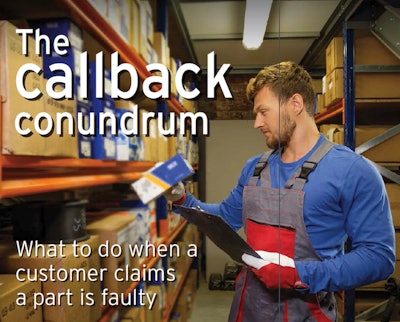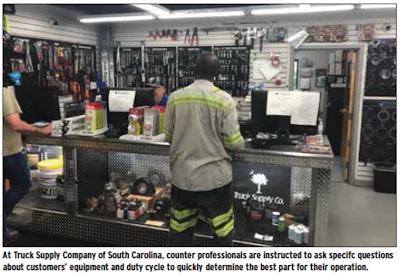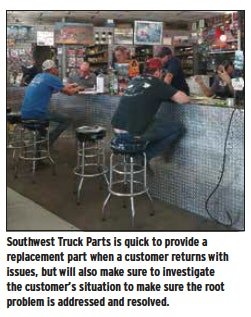The following comes from the June 2018 issue of Truck Parts & Service. To read a digital version of the magazine, please click the image below.

One unfortunate inevitability of the parts distribution business is returns. Commercial trucks and trailers are incredibly advanced equipment. No distributor solves 100 percent of his customers’ problems the first time, every time, and both sides know it.
But while the occasional part return might be expected and sometimes even accepted by most customers, distributors know it’s best to never let one return become a trend. By standardizing responses to parts returns, aftermarket distributors can better solve customer problems, reduce customer downtime and, ideally, increase customer satisfaction.
Is it the right part?
Suppliers say the first step in any distributor parts return process should be to identify the unit in question and determine if it is the correct product for the customer’s needs. This includes checking the component part number and, if the unit in question is not an OE first-fit component, cross referencing the aftermarket component to the OEM part number.
“It is not uncommon for parts to be returned as ‘faulty’ when, in fact, the need for the return is attributable to an innocent purchasing error [meaning the wrong part was purchased for the desired application] or improper installation/use,” says FleetPride’s branch operations team.
Dave Douglass, director of training and education at Muncie Power Products, says most aftermarket purchasing errors can be traced to duty cycle. He gives the example of a used truck owner who instinctively replaces like-for-like for all components despite operating his truck in a dramatically different environment than the previous owner.
Says Douglass: “You likely have an operator who is trying to do things he shouldn’t be trying to do.”
The FleetPride branch operations team says it questions customers on usage and duty cycle before searching for part numbers to ensure the nationwide distributor provides the correct “options to meet their needs.”
In some instances, a veteran counter professional might be able to recall the correct part number for a specific duty cycle from memory. When a counter person is unable to immediately identify a component and its duty cycle, reference tools such as FleetCross by MOTOR can be invaluable.
Paul G. Moszak, vice president and heavy-duty evangelist at MOTOR Information Systems, says the cross-reference tool in FleetCross “allows the user to enter a needed part number and have it cross-reference to something they may have in stock. Part search by word also is available, including access to thousands of aftermarket catalogs.”
In cases where a distributor counter professional does not have access to such a tool, supplier catalogs can fill the void.
While print catalogs can still be found — and are still useful for some components — most suppliers advise distributors to use online catalogs whenever possible because of the up-to-date nature of the information.
“Sometimes an OEM will change a part number,” says Scott Donnelly, director of heavy-duty sales at Dorman HD Solutions. “It is nowhere near as common in the heavy-duty space as the automotive space, but it can happen.”
Was it correctly installed?
If a customer was using the correct part, it’s possible his premature component failure can be traced to a mistake during installation.
“A part failing once can happen. But the second or third time a customer comes back needing the same part, it’s likely because he doesn’t know how to put it on [the truck],” says Edward Neeley, president at Truck Supply Company of South Carolina.

When a customer’s response doesn’t reveal a mistake, Neeley says Truck Supply also will volunteer to assist in the installation of the next part or direct the customer to a service partner it trusts to install the part.
Southwest Truck Parts does the same, says President Debbie Polok. Having one problem with one part doesn’t cause much alarm, but once a customer returns a second time, “we do investigate it,” she says.
“For a lot of the parts we sell there are [installation] instructions in the box,” says Polok. “If there aren’t, or the customer seems to be having trouble, we will offer to bring the truck into our shop and check it out for them.”
Manufacturers are doing their part in this area as well. In addition to installation instructions, many aftermarket suppliers also offer literature and training geared around minimizing installation mistakes and maximizing component performance.
Douglass says Muncie produces wall posters featuring images of common failure modes, descriptions of how they are caused and instructions on what needs to be done to correct them. Dispersed throughout Muncie’s distribution channel, Douglass says the posters provide counter professionals a useful visual aid when encountered with a premature failure.
Determine the root cause

Neeley says this is another reason why careful customer questioning is important.
The more information a distributor or service provider can acquire from a customer at the point of sale, the better advice they can provide the customer before he exits the store.
Similar to Truck Supply, B.A. Friction relies on a series of questions asked during all comeback events to piece together a component’s performance history that can be used to diagnose a problem and develop a solution, says President Harry Amoroso.
“We want to know why the customer thinks the part is defective,” he says. “What was going on to bring them in?”
A lot of times customer explanations will describe symptoms of a common problem found upstream, one likely responsible for the new part’s poor performance.
As that solution unfolds, the B.A. Friction team is trained to fall back on its product expertise and supplier training to instruct the customer on how to fix the larger problem.
“We will give them everything we have: brochures, images, we have access to videos,” says Amoroso, anything to keep the customer “from returning again with the same problem.”
That focus on finality is not something to be overlooked. Once a customer returns the same part multiple times, it’s likely his frustration is no longer focused solely on the component or manufacturer. By that point, everyone in the distribution channel is fair game for scorn.
“You definitely want to make sure you get the customer somewhere where you can help him. Where you can give him the right information so [the part] works,” Neeley says. “We don’t want him coming back again once he leaves because then he can get a bad taste in his mouth about your parts and your business and suppliers.”
When it is a warranty problem

A one-year warranty is common for many aftermarket parts, and most suppliers have their own unique documentation that must be completed by a distributor (with customer information) to approve a warranty claim.
Suppliers note production errors and damage during transportation account for the majority of warranty-related parts returns. Additionally, while premature component failures traced to the mistakes above can occur to nearly any component at any time, parts failing without cause can typically be traced to a single shipment or truckload.
When it comes to identifying those components, suppliers say distributor cooperation plays a key role. Warranty return tracking eventually identifies all batch issues but lacks the immediacy of channel notification. Says Donnelly, “If a distributor has different customers coming in with the same issue, they should push that information to the supplier and let them know they have a problem.”
Polok says that’s the standard operating procedure for Southwest Truck Parts. “If it’s a brand-new part and it comes back a few times, we make sure to tell the rep.”
It’s also important to remember that no matter how a part fails, it is how a distributor responds that ultimately determines whether a customer will remain loyal moving forward.
“The main thing is maintaining that customer rapport,” says Neeley.
Amoroso agrees, adding parts return situations also can be useful opportunities for distributors to teach customers the importance of proper maintenance, spec’ing and installation.
“So many customers today are driven by price, and then something will happen, and we’ll have to tell them: ‘You know you are putting on something other than what is recommended for your truck,’” he says. “Usually when they experience a situation like that it will open their eyes a bit.”










